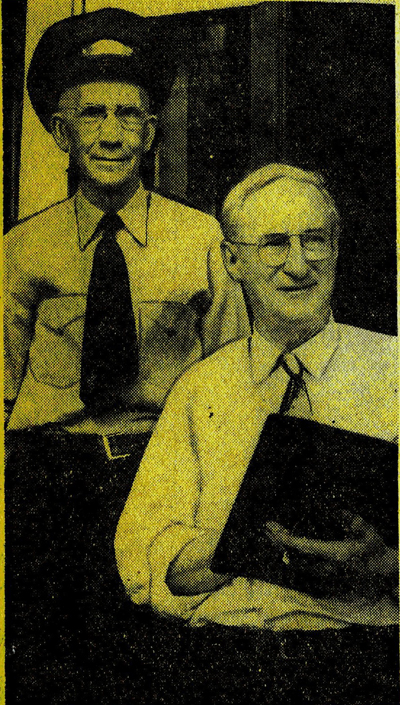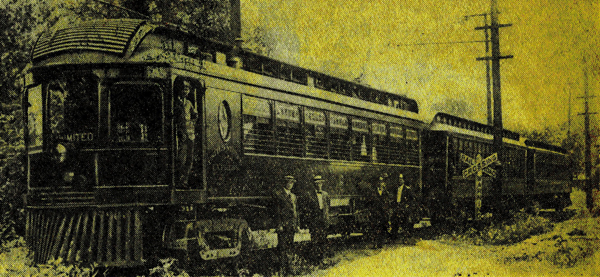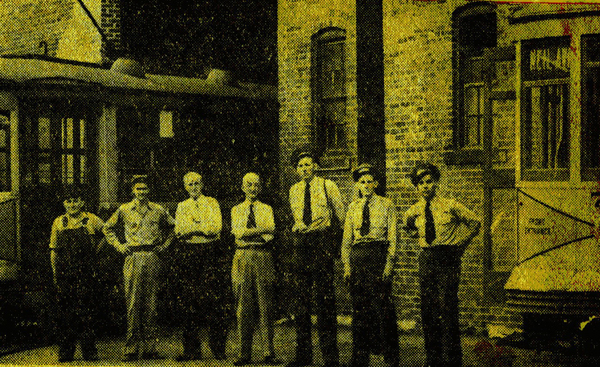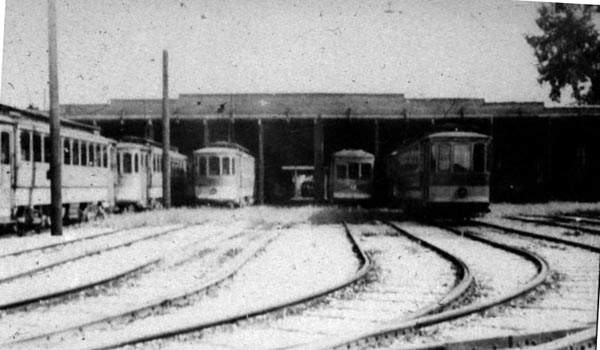|
Rise, Fall of Electric lines Recalled by Floyd Clunis Columbus Dispatch, September 4,1948 By Spike Drugan
Floyd Clunis (at Right) today looks back on a 46-year-old career marked by the flash of wheels on steel rails. With him is a friend, Frank Hutchisson (left), 149 E. Maynard Ave. In the spring of 1902 a young man named Floyd G. Clunis wanted to become a conductor on the Columbus, Buckeye Lake & Newark traction line. He got the job at company’s main office in Newark, Ohio, and has been riding trolley cars ever since. In those 46 years, Mr. Clunis has witnessed the growth and decline of electric powered interurban and local street cars. Mr. Clunis has many memories of those years when the speedy interurbans brought cities closer together. The passing of the horse and buggy became a reality. Saw Rise and fall As superintendent of transportation of the C&SO, with offices in the Kelton Avenue barns, Mr. Clunis had the painful task of dispatching the “last run” Saturday night. Shortly after midnight, the Main and Neil car slowly curved into the shed to complete the last run over the streets of Columbus. The passing of the street car became a reality as did the horse and buggy at the turn of the century. Mr. Clunis regrets it deeply. The story of Mr. Clunis’ career denotes courage. For this smiling Irishman has had its ups and downs. In 1929, when the final collapse of the electric interurban system happened, Mr. Clunis, at the age of 51, lost his job and had to start all over again. From superintendent of the Ohio Electric traction Co., he went back to conductor again. This time with the Columbus Railway, Power & Light car on the Main and Neil line. Again he has come up the hard way to his present position with the Columbus & Southern Ohio Electric Co. “The first run out of Newark that summer day in 1902 was the big thrill of my life. I had both the training of motorman and conductor and it so happened that the first run found me at the controls with Joe Allison as my conductor. “Our route was in Main Street from Hebron and then over the Mound St. trestle after we turned at Bexley. When we arrived downtown the tracks guided me from Mound St. to north on Third St. We turned west at Gay and the depot was at 39 W. Gay, between High and Front Streets. Our return trip took us west on Gay to Water St., then to Rich St. where we again turned, going east to Third and thence to Mound, completing the loop. “I had that run for two years and then was transferred to the Newark office, where I stayed until 1908.” Promoted At this point, Mr. Clunis scratched his head because things began to happen around that period of 1908. When he was transferred to the office, he had received promotion to assistant superintendent of the CBL&N lines. From 1908 through 1909 the traction company was in the process of consolidating and in 1910 the final road was absorbed and the name was then changed to the Ohio Electric Co. In the short space of eight years, Mr. Clunis saw the lines grow from 37 miles and four cars to 555 miles and 200 cars. The following small companies that were consolidated as Mr. Clunis recalls were: CN&Z, Dayton & Columbus, Dayton & Richmond, Dayton & Union City, Cincinnati & Dayton, Springfield & Urbana, Lima & Fort Wayne and the Lima & Defiance line. When the final road was taken in and the Ohio Electric system completed, the company expanded its line by building a road from Lima to Toledo. We were really a growing concern, proudly recalls Mr. Clunis. In 1912 the beautiful new Columbus Interurban terminal at Rich and Third streets was completed. “Travel by Traction’ was the word of that era,” Exclaimed Mr. Clunis. Road Prospered The Ohio Electric prospered and in 1918 Mr. Clunis was notified that he was to take over the position of superintendent with offices in the terminal building here in Columbus. Mr. Clunis recalls many personalities that rode the traction lines. He especially recalls the time gen. John J. Pershing was making a tour of Camp Sherman in 1917. “Mayor George Karb personally approached me that winter day and asked me to see that the depot was cleaned like a whistle for Pershing was a stickler for such things as dirt. “I got the boys to work and when the famous general arrived from Chillicothe over the Scioto Valley, he made a couple of hurried handshakes and didn’t even notice how clean we made the terminal. Pershing stayed only a minute and departed for Dayton. “Mayor Karb roared at that one and never forgot it to his dying day,” said Mr. Clunis. Hit By Flood “The flood of 1913 was disastrous to our company,” recalls Mr. Clunis. “We didn’t realize it at the time but the loss was probably instrumental in the later decline of the Ohio Electric lines into bankruptcy. Over 20 bridges were washed out and the Zanesville power house was a complete machinery loss. The damage totaled over four million dollars and we never fully recovered, said Mr. Clunis. The final collapse came for the Ohio Electric in 1929. The only road left was the run to Dayton which the C&LE had taken over a few years previously when the Ohio Eclectic was under receivership. Bus service finally replaced the C&LE traction. “It was a sorry sight for 300 of us that had spent so many years in building. The C&LE offered me a job but I could see the handwriting on the wall. I accepted the job as conductor on the local Main and Neil lines,” said Mr. Clunis. Now Checks Buses And here he has been ever since. At the age of 70, Mr. Clunis still carries on and will continue as a bus checker for the Columbus & Southern Ohio company. There were 11 lines in service in Columbus in 1929, recalls Mr. Clunis. “I believe there was about 300 miles of track and nearly 400 cars then.” Mr. Clunis recalls only one serious accident in all 46 years. This happened in 1910 and in this case he was a passenger on car 166, coming from Buckeye Lake. “As I remember it,” says Mr. Clunis, “W. D. Crane was motorman. Crane had asked Conductor Allison to get me out of the smoker as he wanted to see me. This happened as we were slowly approaching the Alum Creek trestle around 8 p. m. It was in the fall and was quite dark then.” “As the car approached the slight curve in the center of the trestle, the head light suddenly lit up the images of two women who were trying to run to safety on the open ties. I grabbed the handbrake at once while motorman Crane slammed on the air and reversed the motor. One woman reached safety by hanging to a tie but our cow catcher hit the other women and she fell to her death on the N&W tracks, 100 feet below.” As a parting gesture, Mr. Clunis remarked that many happy times occurred, however. “People were closer together it seemed then. We had more clean fun and enjoyed life more easily. One thing I wish I had,” said Mr. Clunis, “I wish I had a dollar for every sailor hat that flew out the windows of those electric cars.”
|



